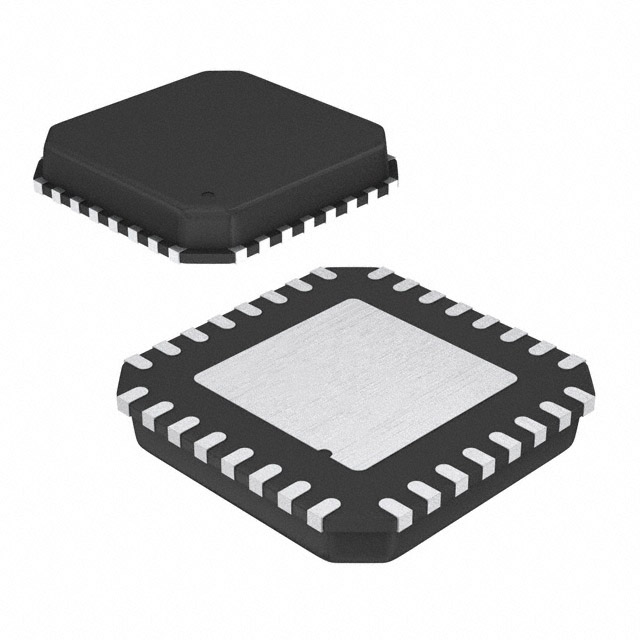Szczegóły produktu można znaleźć w specyfikacjach.

ATTINY461A-MU
Product Overview
Category
The ATTINY461A-MU belongs to the category of microcontrollers.
Use
This microcontroller is commonly used in various electronic devices and embedded systems.
Characteristics
- Low power consumption
- High performance
- Small form factor
- Wide operating voltage range
Package
The ATTINY461A-MU is available in a compact surface-mount package.
Essence
This microcontroller is designed to provide efficient and reliable control for electronic applications.
Packaging/Quantity
The ATTINY461A-MU is typically packaged in reels or tubes, with a quantity of 2500 units per reel/tube.
Specifications
- Microcontroller architecture: AVR
- CPU speed: 16 MHz
- Flash memory: 4 KB
- RAM: 256 bytes
- EEPROM: 256 bytes
- Digital I/O pins: 20
- Analog input channels: 8
- Communication interfaces: SPI, I2C, UART
- Operating voltage: 1.8V - 5.5V
- Operating temperature range: -40°C to +85°C
Detailed Pin Configuration
The ATTINY461A-MU has a total of 32 pins, which are assigned different functions based on their configuration. The pinout diagram below illustrates the detailed pin configuration:

Functional Features
- Advanced RISC architecture for efficient processing
- Multiple communication interfaces for seamless integration
- Built-in analog-to-digital converter (ADC) for precise measurements
- Timers and counters for accurate timing operations
- PWM outputs for controlling analog devices
- Sleep modes for low power consumption
Advantages and Disadvantages
Advantages
- Low power consumption makes it suitable for battery-powered applications
- Compact size allows for integration in space-constrained designs
- Wide operating voltage range provides flexibility in various power supply scenarios
- High-performance CPU enables fast and efficient processing
Disadvantages
- Limited amount of flash memory and RAM may restrict the complexity of applications
- Lack of built-in peripherals may require additional external components for certain functionalities
Working Principles
The ATTINY461A-MU operates based on the AVR architecture, utilizing a combination of hardware and software to execute instructions. It follows a sequential execution model, where instructions are fetched from memory, decoded, and executed by the CPU. The microcontroller interacts with external devices through its I/O pins and communication interfaces.
Detailed Application Field Plans
The ATTINY461A-MU finds applications in various fields, including but not limited to: - Home automation systems - Industrial control systems - Consumer electronics - Automotive electronics - Internet of Things (IoT) devices
Detailed and Complete Alternative Models
- ATTINY461V-10MU
- ATTINY461-20MU
- ATTINY461-SSU
- ATTINY461A-SU
These alternative models offer similar functionality and characteristics to the ATTINY461A-MU, providing options for different application requirements.
In conclusion, the ATTINY461A-MU is a versatile microcontroller that combines low power consumption, high performance, and a compact form factor. With its wide range of applications and availability of alternative models, it serves as a reliable choice for various electronic designs.
Word count: 511
Wymień 10 typowych pytań i odpowiedzi związanych z zastosowaniem ATTINY461A-MU w rozwiązaniach technicznych
Sure! Here are 10 common questions and answers related to the application of ATTINY461A-MU in technical solutions:
Q: What is ATTINY461A-MU? A: ATTINY461A-MU is a microcontroller from the AVR family, manufactured by Microchip Technology. It offers 4KB of Flash memory, 256 bytes of EEPROM, and 256 bytes of SRAM.
Q: What are the key features of ATTINY461A-MU? A: Some key features of ATTINY461A-MU include 20 general-purpose I/O pins, 8-channel 10-bit ADC, 16MHz internal oscillator, UART, SPI, and I2C interfaces.
Q: What are some typical applications of ATTINY461A-MU? A: ATTINY461A-MU is commonly used in applications such as industrial control systems, home automation, sensor networks, consumer electronics, and battery-powered devices.
Q: How can I program ATTINY461A-MU? A: ATTINY461A-MU can be programmed using various development tools like Atmel Studio, Arduino IDE, or other compatible programming environments that support AVR microcontrollers.
Q: Can ATTINY461A-MU be used for low-power applications? A: Yes, ATTINY461A-MU is designed for low-power operation. It offers multiple sleep modes, power reduction techniques, and clock prescaling options to optimize power consumption.
Q: What is the maximum operating frequency of ATTINY461A-MU? A: The maximum operating frequency of ATTINY461A-MU is 16MHz when using the internal oscillator. It can also be operated at lower frequencies if power-saving is a priority.
Q: Does ATTINY461A-MU support communication protocols like I2C and SPI? A: Yes, ATTINY461A-MU has built-in hardware support for both I2C (Two-Wire Interface) and SPI (Serial Peripheral Interface) communication protocols.
Q: Can ATTINY461A-MU be used with external sensors or peripherals? A: Yes, ATTINY461A-MU can interface with various sensors and peripherals using its GPIO pins, UART, I2C, and SPI interfaces.
Q: What is the maximum voltage that ATTINY461A-MU can handle? A: ATTINY461A-MU can handle a maximum voltage of 5.5V. It is important to ensure that the input voltage does not exceed this limit to prevent damage to the microcontroller.
Q: Are there any development boards available for ATTINY461A-MU? A: While there might not be specific development boards dedicated to ATTINY461A-MU, it can be easily integrated into custom PCB designs or used on breadboards with appropriate supporting components.
Please note that these answers are general and may vary depending on specific requirements and implementation details.

